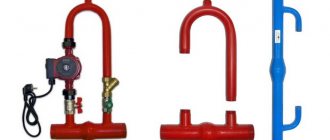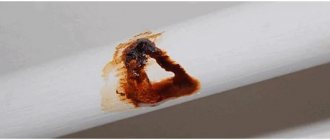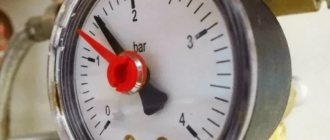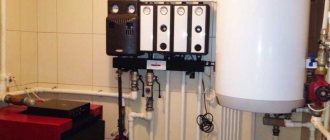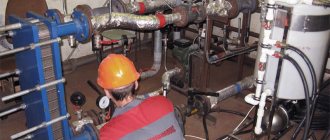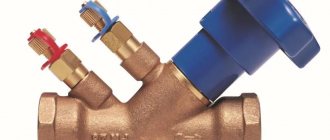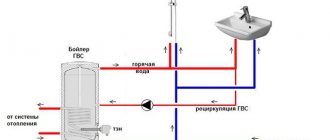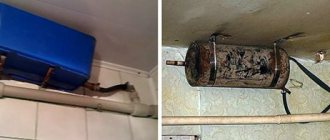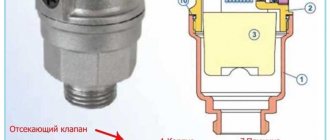A situation with a leaking heating circuit is not uncommon, since the heating system consists of many components and elements, the tightness of their connection with each other is sooner or later broken. In addition to joints, a depressurization zone can also be an entire span of pipe that is physically worn out or damaged due to the influence of some factor.
Sealant for heating pipes, available in different types and designs, helps solve the problem of a leak or ensure long-term tightness of the connections of its elements during installation of the system.
Types of sealants
Each of the sealants is good for specific living conditions, but for repairing heating equipment, special sealants for heating systems are better suited.
In modern everyday life, a large number of products with sealing properties are used.
Based on their chemical composition, sealants are divided into the following main types:
- acrylic - unstable, do not tolerate temperature changes;
- polyurethane - elastic, have high adhesion to metals, resistant to corrosion and temperature;
- silicone - the most common type of universal sealants, retain elasticity and moisture resistance over a wide temperature range, and are durable.
When sealing leaks in metal elements of a heating system with silicone sealant, it is permissible to use only its neutral variety, but not the acidic one, since the acetic acid contained in the acidic sealant will cause active corrosion of the metal.
The use of adhesive sealant will replace the need to use other methods of sealing threaded connections.
Heat-resistant sealant for heating pipes is used for metal and polymer materials. This product properly fulfills its purpose - to prevent the penetration of moisture from damaged elements of the heating system. The sealing substance, which is a viscous mass, hardens quite quickly at the site of application and subsequently withstands high temperatures.
To seal threaded connections in modern heating networks, anaerobic adhesive sealant is used instead of flax tow and FUM tape. The environmental friendliness of such a sealant allows it to be used not only in heating systems, but also in plumbing systems.
Sealant for heating boilers is used to eliminate gaps in places where heat resistance of the material up to 1500°C is required.
Using this product, it is possible to seal cracks in heat exchangers and chimneys of boilers and furnaces. After hardening in the seams between surfaces of different materials (metal, brick, concrete), the substance retains its tightness.
Requirements for sealing materials for heating systems
The first thing that needs to be done if the tightness of the heating system is broken is to eliminate the coolant leak, thoroughly or temporarily - before major repairs are carried out. And the main thing that needs to be ensured when installing heating is its reliable tightness.
The listed factors determine the requirements for sealants used in the installation and repair of water heating systems:
- ease of use;
- heat resistance;
- high adhesion and strength;
- fairly rapid achievement of a sealing effect;
- safety of use.
The better liquid sealant for heating repairs
The increased heat resistance of some special sealants makes it possible to use them for prompt repair of heating boilers.
For heating repairs, it is not always possible to use external agents. What to do, for example, if the location of the leak cannot be detected because the house had hidden pipes and installed a heated floor? Will we really have to break down the walls and open up the floors? No, you don't have to! In such situations, a relatively new method of eliminating leaks is used - by pouring liquid sealant for heating pipes into the system. This sealant is also suitable for radiators when it is not possible to apply a clamp to a leak.
The fundamental difference between liquid sealants for heating systems is their ability to eliminate leaks not by applying to the damaged area from the outside, but directly from the inside.
In an emergency, it is permissible to pour sealant intended for car radiators into the heating system
The essence of this method is that when mixed with a coolant, the sealant remains liquid, and only upon contact with air penetrating into the system does it polymerize. Gradually hardening, the sealant clots are sealed from the inside of the crack exactly in those places where the integrity of the system is compromised.
Several types of liquid sealants for heating are produced, each of which is adapted to special conditions of use, in particular:
- the coolant is water or antifreeze;
- gas or solid fuel boiler;
- heating or water pipes.
You should not try to look for one universal sealant for your home heating system. It is better to purchase a specialized composition for the specific parameters of your heating system.
The most famous among consumers are liquid sealants for heating systems produced by the German company BCG. The use of these products is considered an ideal solution for eliminating hidden coolant leaks. When used correctly, liquid sealant does not pose a danger to heating boilers and does not cause damage to the circulation pump and measuring instruments.
Sealant for pipes and heating radiators must remain in the system for a long time. Once you add this sealant to your heating system, you can forget about leaks for several years.
Sealants for closed heating systems eliminate pressure losses associated only with leaks in pipes and radiators, but are powerless in cases where the membrane in the expansion tank is damaged.
What to rely on when choosing
To eliminate leaks in a heating pipe, almost any sealants (acrylic, silicone, etc.) are used.
When choosing the optimal substance, pay attention to price, temperature conditions, resistance to water and mechanical deformation. And also remember some subtleties:
And also remember some subtleties:
- If the heating installation is not located in the house, then it is advisable not to use acrylic sealant, since it does not tolerate water and mechanical damage (for example: if water gets into a crack during prolonged rain, this will lead to cracking of the substance).
- Acrylic sealant is also not recommended for use when a powerful heating boiler is installed, as the product can crack at very high temperatures. It is better to give preference to heat-resistant silicone and thiokol mixtures.
- To seal threaded connections, it is recommended to use silicone and thiokol sealants, since after hardening they do not deform and do not clog the thread.
Reference. In everyday life, it is recommended to use silicone sealant to solve most problems, as it has good performance characteristics and a low price.
Steps to eliminate a leak with liquid sealant
Before you start sealing possible leaks in the heating system, you need to make sure that the expansion tank is in good condition.
The procedure for using liquid sealants to repair a home heating system may seem quite complicated. In some cases, clots of sealing fluid cause partial blockage and impede the movement of the coolant. Therefore, in order not to cause damage to the heating equipment due to your inexperience, it is better to invite a specialist. In any case, you need to study the instructions for using a specific type of sealant for radiators and strictly follow them.
Having decided to use a liquid sealant to fix a problem in the heating system, you need to make sure that:
- the reason for the pressure drop is precisely the leakage of coolant, and is not related to a malfunction of the expansion tank;
- the selected type of sealant for heating systems corresponds to the type of coolant in the system;
- The sealant is suitable for this heating boiler.
German liquid sealant BCG-24 is used to eliminate leaks in heating systems
When using liquid sealant for pipes and radiators, it is important to maintain the correct concentration. On average, its values range from 1:50 to 1:100, but it is advisable to determine the concentration more accurately, since the effectiveness of eliminating leaks can be affected by factors such as:
- coolant leak rate (up to 30 liters per day or more);
- the total volume of water in a given heating system.
If the volume does not exceed 80 liters, 1 liter of sealant will be enough to pour into the heating system. But how can we more accurately calculate the volume of water in the system? You need to calculate how many meters of pipes and what diameter were laid in the house, and then enter this data into one of the online calculators. To the resulting volume of pipelines, you must also add the passport characteristics of the volumes of all radiators and the boiler.
You can drain all the water from the system into a certain container, the volume of which is precisely known, and then fill the system again.
Preparing the heating system
- Dismantle or cut off all filters with taps so that they do not become clogged with a viscous solution of sealant for heating systems;
- Unscrew the Mayevsky valve from one radiator (the first one in the direction of coolant flow) and connect a pump to it (the “Baby” type);
- Start the heating system and let it warm up for an hour to a temperature of 50–60°C at a pressure of at least 1 bar;
- Open all taps on pipelines and radiators to allow sealant to flow freely through them;
- Remove air from the entire system, including the radiators and circulation pump.
If the air is not completely vented, it will begin to react with the sealant and cause it to thicken in places other than where it is needed to eliminate the leak.
Preparing the sealant
You can also pour liquid sealant into the heating system using a hand pump for pressure testing.
Drain about 10 liters of hot water from the system into a large bucket, most of which is used to prepare the sealant solution, and leave a few liters for subsequent flushing of the pump;- Shake the canister (bottle) with sealant for radiators and heating pipes, then pour its contents into a bucket;
- Rinse the canister thoroughly with hot water so that all remaining sediment gets into the solution being prepared.
Solutions of sealants for heating systems must be prepared immediately before use so that the liquid does not come into contact with atmospheric air for too long.
Pouring sealant
Liquid sealant for heating systems must have time to mix with the coolant before it reaches the boiler, so it is more advisable to pour it into the supply:
- Introduce liquid sealant solution into the system using a pump;
- Pump the remaining hot water through the pump so that absolutely all of the sealant sediment gets into the system;
- Bleed the air from the system again;
- Raise the pressure to 1.2–1.5 bar and maintain the system operating cycle for 7–8 hours at a temperature of 45–60°C. This period is needed for the sealant to completely dissolve in the coolant.
The operation of heating equipment cannot be stopped for several days until the polymerization of the liquid heating sealant is completed.
Preparatory work before refilling batteries and pipes
First, choose the best sealant that will suit your system.
Before purchasing, pay attention to the consumption of the active substance. For every 60 liters of coolant water in the pipes, about 1 liter of sealant is required, however, these figures may vary depending on the type of sealant
To determine the volume of coolant, multiply the cross-sectional area by the total length of the pipe. And also add to this indicator the volume of radiators and boiler (this information is indicated in the installation passport).
Important! The calculation can be done by direct measurement - for this, all the water is drained from the pipes and the volume is measured using containers of a known size. This method is more labor-intensive, but more reliable.
The process of setting up for pouring
Complete the process of setting up the system for pouring:
- Remove air from the heating system, as premature solidification will lead to the formation of unwanted clots in the system.
- If the system has filters, remove them so as not to damage the system.
- Open all valves of the heating system so that the sealant penetrates every work area.
- Install an automatic pump on the first radiator. Turn it on for 1-2 hours to warm the pipe and remove remaining air (the optimal pressure level is 1 bar).
Pouring procedure
After that, start filling:
- Prepare a large container for preparing the solution.
- Pour the required amount of water into it.
- Add sealant and mix the solution.
- Immediately introduce the solution into the heating system using a pump to minimize contact of the sealant with air.
- Start the heating system in normal mode (the optimal water temperature is at least 50 degrees).
- You need to run the sealant with the coolant for at least 4 days, and on the 5th day it is recommended to carry out control measures to check whether the sealing is effective or not.
How does the sealing effect manifest itself?
You should not expect the leak to be eliminated immediately, but only on the 3rd or 4th day. During this time, the sealant for heating pipes will compact and close the cracks in problem areas from the inside. Eliminating the problem of coolant leakage will manifest itself in the fact that the sound of falling drops of liquid will no longer be heard in the house, moistened areas on the floor will dry out, and the pressure in the system will no longer decrease.
At the same time, one of the negative effects may be a slight blockage of passages in devices for distributing coolant flow, as well as in thermostats. But this problem can be easily solved by periodically opening and then adjusting these types of regulators to the desired position to prevent them from further sticking.
When working with liquid sealant for heating systems, the same strict precautions must be observed as those prescribed for working with all kinds of chemicals!
The video lesson will help you understand how to fix a leak in your heating system yourself using liquid sealant.
Based on all that has been said, you can be sure that liquid sealant is undoubtedly worth using to eliminate leaks in the heating system. Even though its price is steep. However, it should be understood that hidden installation of heating pipes is not only a convenience, but also a certain risk, for which you sometimes have to pay.
How the authorities of Sevastopol created problems for the state port
According to information available to ForPost from its own sources, on the evening of January 17, in the government of Sevastopol, employees of special services were indeed seizing documents in the case of the possible deliberate bankruptcy of the Sevastopol Sea Port. It is for this reason, the source reports, that the regional governor, Dmitry Ovsyannikov, refused to meet with Syrian President Bashar Assad during a trip abroad and flew to Sevastopol.
Let us recall that earlier a number of online sources and alternative media reported about a conflict that flared up within the walls of the city-regional government around the anti-corruption unit, which discovered possible traces of the deliberate bankruptcy of Northern Seaport.
Official sources
At the same time, public sources contain enough information indicating that the government structure of Dmitry Ovsyannikov took steps that likely have a chance of creating great financial difficulties for Sevmorport.
The point is that at the end of 2022, the Department of Property and Land Relations of Sevastopol flooded Sevmorport with lawsuits for debt collection. Let's give a few such examples.
The Sevastopol Arbitration Court made the first decision in favor of the government on October 30, 2022, obliging Sevastopol Sea Port to recover 1 million 750 thousand rubles of debt for renting a land plot (a warehouse located on the 5th km of Balaklava Highway) for the period from September 29, 2017 to 05/31/2018
The second decision to collect 265 thousand rubles of debt in favor of the government for renting a land plot in Kamyshovaya Bay (with berths No. 221, 222, 223, 224, 225, 227, 228, 229, 230) was made by the Arbitration Court on November 13, 2022.
And on November 28, 2022, the Arbitration Court of Sevastopol made a third decision - to recover from Sevmorport 687 thousand rubles of debt for renting a land plot on Rybakov Street, 5.
Unprofitable enterprise
Thus, the state enterprise “Sevastopol Sea Port”, created by the government of Sevastopol itself in June 2014, at the end of 2022 found itself with debts of more than 2.7 million rubles only based on the results of three ships. Add to this the likelihood of other financial problems that we are not yet aware of, as well as the fact that as of the last reporting year, Sevmorport had a negative profit of about 1.94 million rubles, and we get a very unfavorable picture.
Why a state-owned enterprise established by the government of Sevastopol, which includes the entire maritime infrastructure of the region associated with maritime cargo and passenger transportation, found itself in such a situation is a big mystery.
How to eliminate leaks in hidden wiring pipes
To quickly seal hidden heating pipelines, use mustard powder or a ready-made special sealant. The existing substance is added to the expansion boiler and the system is put into operation. After a few hours, the sealant (or particles of mustard powder) will seal the damaged area, eliminating the leak.
Such repairs will give time to prepare for a complete restoration of the heating circuit. However, if a large damage has occurred in a hidden area, then the internal sealant is unlikely to help. The heating circuit will have to be drained and repaired immediately.
Affordable repairs begin with the correct design and installation of the heating system. All detachable connections must be accessible for inspection. Hidden areas must be made of high-quality, durable materials and not have detachable connections. Timely replacement of worn-out equipment will allow you to live peacefully in cold weather, enjoying warmth and comfort.
Sealing with plumbing thread
A prerequisite for applying thread is a thread with notches. If the thread is smooth, then a wrench should be used to apply notches. The thread is wound starting from the third turn. Despite the fact that it is written on the thread that you can wind it any way you like, it is best to wind it carefully, so that there are no free spaces.
After this, the thread should have free first two turns, just like in the case of flax, and a seal on the last two turns. If the procedure is performed correctly, with strict adherence to technology, the sealing of threaded connections will be reliable and will last a long time.
Fill
Approximately a bucket of heated coolant is poured into a separate clean container. In the other - another half bucket (for future washing). The product is worth chatting and pouring into a bucket. Make sure that the sealant does not come into contact with air for a long time. It needs to be quickly pumped into the heating system.
Again the air is removed from the networks.
The sealant circulates through the heating circuits for several hours. The process of sealing gaps and leaks will be completed in four days. On the fifth day, you need to test the system under high pressure.
And remember, heating system sealant is definitely worth using to prevent leaks. And even though its cost will seem quite high to many. Hidden reconstruction of heating pipes is both a convenience and, at the same time, a certain risk, for which you sometimes have to pay.
The diameter of the heating pipes is 25 or. Calculation methods
How to calculate the diameter of heating pipes? There are several methods:
- According to special tables. However, their use still requires preliminary calculations: the power of the heating system, the speed of movement of the coolant, as well as heat loss along the main line.
- By thermal power.
- According to the resistance coefficient.
What you need to know to calculate
To carry out the calculation you will need the following data:
- Heat demand (thermal power) of the entire house and each room separately;
- The total power of the heating devices used (boiler and radiators).
- Thermal load on individual sections of the circuit.
- The total heat loss of the house and each room separately during the coldest winter period.
- Resistance value. It is determined by the wiring diagram, the length of the line, the number and shape of bends, connections, and turns.
- The total volume of coolant loaded into the heating main.
- Flow speed.
- Circulation pump power (for forced heating).
- Line pressure.
Calculation of pipe cross-sections for heating systems with forced air circulation:
Calculation procedure
- Calculation of required thermal power.
- Determination of the circulation rate of the carrier in the heating system.
- Calculation of heating circuit resistance.
- Calculation of the required pipeline cross-section.
- Calculation of the optimal diameter of the heating collector (if necessary).
Calculation of system thermal power
Method 1. The simplest way to calculate thermal power is based on the established standard of 100 watts per 1 m² of room. Those. with a house area of 180 m², the power of the heating circuit will be 18,000 watts or 18 kW (180 × 100 = 18,000).
Method 2. Below is a formula that allows you to adjust the data taking into account the power reserve in case of severe frosts:
However, these methods are characterized by a number of errors, because does not take into account the range of factors influencing heat loss:
- ceiling height, which can vary in the range from 2 to 4 or more meters, which means that the volume of heated rooms, even with the same area, will not be constant.
- the quality of insulation of the house facade and the percentage of heat loss through external walls, doors and windows, floor and roof;
thermal conductivity of double-glazed windows and materials from which the house is built.
Climatic conditions of the regions.
Method 3: The method presented below takes into account all the necessary factors.
- The volume of the entire house or each room separately is calculated using the formula:
V = h×S,
Where:
- V – Volume of the heated room.
- h – Ceiling height.
- S – Area of the heated room.
So which one should you choose?
This review is published to make it easier for you to choose the sealant or adhesive that best suits your situation. It contains sealants and adhesives from different manufacturers and price categories, as the popularity of the compositions decreases
Attached to the review will be a small reminder of what properties of the glue and under what circumstances you should pay attention first. So, if you only need to glue a tin screen onto a heating radiator, there is no point in using glue with a tensile strength of 100 kg - there will definitely not be such loads
In this case, it is better to pay attention to durability and resistance to external influences. There is also no point in fixing a leak in the radiator of your favorite car with a sealant designed for 1500°C. Now a small list of the main properties of sealants and adhesives will be given, which will help you understand a little about what you should pay attention to.
Types of high-temperature adhesives and heat-resistant sealants
Characteristics of heat-resistant adhesives
For heat-resistant adhesives, the main quality is, of course, heat resistance itself, that is, the preservation of its properties under temperature changes. The next equally important characteristic is the level of strength. Next comes adhesion; it differs with different adhesives and sealants and with different materials.
Next, depending on the operating conditions, we pay attention to resistance to aggressive substances, weather conditions and mechanical stress. Also, the hardening time, which is usually indicated on the packaging, sometimes plays an important role.
Types of heat-resistant adhesives
All adhesives according to their composition are divided into 2 main groups - natural and synthetic. Natural composition includes elements from the groups of silicates and carboranes. Synthetic ones include various polymers. Synthetic adhesives are often two-component and consist of the glue itself and a hardener (a substance that activates polymerization).
- based on epoxy polymers - retain properties for 30,000 hours at temperatures up to +150°C, suitable for gluing almost any materials;
- based on organosilicon compounds (silicones) - retain properties for 2000 hours at temperatures up to +400°C, are suitable for repairing fireplaces, stoves and chimneys, and are also used in repairing car engines and sealing various components and assemblies. operating at high temperatures;
- based on organoboron compounds (carboranes) - up to 1000 hours at temperatures of +600°C and above, are used mainly in the repair of stoves, fireplaces, chimneys and other similar structures, but some types of such adhesives have nevertheless found application in other areas;
- inorganic - a short period of time up to 2000 ° C, at lower temperatures - indefinitely, used mainly in structures using open flames.
Characteristics of heat-resistant sealants
As with adhesives, heat resistance, strength and adhesion are just as important for sealants. Only, unlike adhesive compositions, for which this criterion is less important than strength, sealants must also have elasticity and resilience. High-quality compositions must retain it throughout its entire service life and not lose it from exposure to temperatures, weather and other influences.
Types of heat-resistant sealants
- heat-resistant have an operating temperature of up to +300°C;
- heat-resistant sealants are able to maintain their properties at temperatures up to +1200°C.
Sealants, like adhesives, can be divided into natural and synthetic. This separation occurs on the same principle as with adhesives - depending on the components included in their composition.
In addition to what has been said, I would like to supplement our review with several more positions of adhesives and sealants, undeservedly forgotten by cruel statistics, but rightfully deserving of a place at the top of our list.
About the pros and cons of glycol antifreeze
The main advantage of artificial coolants based on glycols is the preservation of the liquid phase at subzero temperatures. We list other positive aspects of using antifreeze in closed water heating systems:
- coolants do not contain calcium and magnesium salts, which form scale inside the heat exchangers;
- due to the penetrating ability of glycols, the effect of lubrication of moving parts occurs, ball valves and thermostatic valves do not sour, the fittings last longer;
- the boiling point of antifreeze 103-106 °C delays the moment of vaporization and airing in case of overheating of a solid fuel boiler;
- When the temperature drops below the freezing threshold, glycol solutions turn into a gel mass.
When glycol mixtures freeze, they form a slurry that is unable to rupture pipes and heat exchangers.
Let us explain the last 2 points. Ordinary water, often poured into the heating system of country houses, begins to boil at 96-98 ° C, actively releasing steam. If the circulation pump is on the TT boiler supply, the steam phase penetrates the chamber with the impeller, water pumping stops, and the boiler completely overheats. A higher boiling point of antifreeze will delay the moment of the accident.
Unlike water, glycol hardened in the cold does not expand and does not destroy pipe walls. In the event of freezing, the only unit that will suffer is the forced circulation pump. The crystallizing gel will jam the impeller and the motor will burn out.
Unfortunately, there are plenty of disadvantages to non-freezing substances:
Ethylene glycol is poisonous and requires careful handling and disposal of the solution. Glycerin and polypropylene glycol are harmless. The heat capacity of the “anti-freeze” is 15% less
To deliver the required amount of heat to the batteries, the liquid flow will have to be increased. The viscosity of antifreeze creates additional hydraulic resistance. You will need a more powerful and expensive circulation pump. Good turnover is a double-edged sword. Glycols penetrate through the slightest leaks, from which plain water cannot flow.
Coolants and additives decompose during operation, losing their frost-resistant properties and forming flakes of sediment. The maximum service life of 1 refill is 5 years, then the heating is flushed and replaced. When using antifreeze, many gas boiler manufacturers void the warranty of the purchased product.
Glycol liquids are poorly compatible with electric boilers. Instructions for the use of various antifreezes categorically do not recommend filling systems operating in conjunction with electrolysis heaters with antifreeze. That is, for electrode boilers of the “Galan” type, a special coolant developed by the specified company is needed.
Under rare circumstances, antifreeze can release flammable gas that breaks through the automatic air vent. Example: the heat source is an electric boiler, the heaters are Chinese-made aluminum radiators. Heating glycol causes a complex chemical reaction and gas formation. The fact is demonstrated in the video:
Classification of high-temperature compounds
The characteristics of sealants depend on the base of the thermal insulating paste. For the treatment of fireplaces and stoves, compositions based on silicate and silicone are suitable. The first group is heat-resistant sealants that can withstand direct contact with flame, the second group is heat-resistant pastes. Their operating temperature is significantly lower than refractory compounds.
Each type of sealant has its own characteristics and priority areas of use.
Silicate – heat-resistant mixtures
Sealing paste based on sodium silicate. Externally, the material looks like a viscous black mixture. After hardening, an inelastic layer is formed on the surface.
Due to the formation of a rigid seam, it is better to use such sealants in ovens that have already had time to shrink, as well as in devices where the likelihood of vibration loads is reduced
If this requirement is neglected, there is a risk of cracking of the insulating seam.
Technical characteristics of silicate compositions:
- permissible temperature indicators: short-term – 1400-1500°C, long-term – up to 1300°C;
- hardening time – 15 minutes;
- maximum seam thickness – 15 mm;
- release form: plastic tubes;
- linear deformation without destruction of the frozen mass – 7%;
- application conditions – temperature within 1-40°C, the exact value depends on the manufacturer.
Silicate compounds have good adhesive properties. To increase the reliability of the coupling, it is advisable to pre-treat a metal, concrete or brick base with an abrasive.
Not all heat-resistant pastes are fire-resistant sealants and are able to retain their properties when exposed to flame. The packaging must bear the appropriate inscription
Heat-resistant paste is most effective when sealing joints of fixed elements with a similar expansion coefficient.
When is it advisable to use silicate sealant:
- sealing cracks in combustion chambers and other surfaces in contact with fire, as well as high-temperature gases;
- sealing cracks formed between steel and cast iron elements of stove appliances and brickwork;
- sealing of chimneys that discharge high-temperature gases, for example: solid fuel boilers and sauna stoves;
- processing of casting installation areas;
- eliminating leaks in heating boilers.
Heat-resistant pastes are used when assembling a sandwich chimney - the joining surfaces are treated with sealant.
Silicone – heat-resistant seals
Silicone-based insulating paste has a brownish-reddish color. The shade is due to the addition of iron oxide to the product. Heat-resistant silicone sealants with different operating temperatures are available for sale, the range of values being 170-300°C.
High temperature oven compounds are often confused with automotive sealants. However, they are not interchangeable. Distinctive features of pastes for heating devices: absence of a sharp acidic odor and packaging in tubes, not small tubes
Silicone sealants retain elasticity after drying - the seams are not afraid of deformation loads and shrinkage of ovens. An additional plus is excellent water resistance, which allows the composition to be used to seal cracks in areas where the roof and chimney come into contact. Silicone paste cannot be painted.
Technical characteristics of heat-resistant seals:
- operating temperature range – within +300°С;
- packaging – tubes, packed in 310 ml;
- Drying period – about 20 minutes;
- application on a cold base at above-zero air temperature, but not more than +40°C;
- resistance to UV rays;
- sealing cracks with a depth of 6 mm.
The cost of silicone thermosealant is often lower than its silicate counterpart. However, due to the insufficient temperature threshold, its use is limited to the treatment of not too hot surfaces.
Scope of use:
- sealing brick chimneys in street areas;
- sealing the joints of the exhaust duct and roofing material;
- treatment of smoke exhaust ducts made of metal, brick and sandwich panels, provided that boilers with an efficiency of over 90% are used - the temperature of the exhaust gases does not exceed +150°C;
- treatment of blind cracks on brick external surfaces of stoves and fireplaces.
The high-temperature composition is also suitable for sealing threaded connections when installing heating circuits.
Let's outline the scope of application
Construction supermarkets sell many sealing pastes used in heating, plumbing and sewerage systems. You must understand that ordinary food and plumbing sealants are not high-temperature, although they are used for installing some elements of chimney pipes.
Deep cracks can be sealed with mortar, but it is better to fill them with heat-resistant sealing paste
Water- and heat-resistant sealants are used for steel stoves, masonry, and fireplace repairs. Application options:
- Sealing cracks and holes in the walls of a combustion chamber built of brick or welded metal.
- Sealing chimney pipes during repair or installation.
- Exterior finishing of brick fireplaces and stoves.
- Bonding heat-resistant gaskets (asbestos and graphite-asbestos cords) to metal fittings - doors, valves, iron ovens and cast iron stoves.
- Waterproofing of roof junctions with chimneys made of metal and brick.
Note. Some repair compounds are even used to restore refractory masonry made of fireclay bricks. One condition: the maximum temperature in the firebox is 1500 °C.
A crack in the stove masonry or welded joint of a steel firebox leads to smoke in the heated room and the formation of soot in the defect area. The traditional way to eliminate it is to move the stove or cover the through gap with clay. Modern high-temperature sealant allows you to solve the problem much faster and more efficiently.
A cracked brick chimney often needs to be rebuilt
The suction of street air into the chimney pipe is a very unpleasant phenomenon. More condensation and soot fall on the walls, which can ignite at any time due to the high temperature of the flue gases. Hence the need arises to seal the connections between the chimney elements. We will discuss other methods of application in detail during the review of repair compositions.
